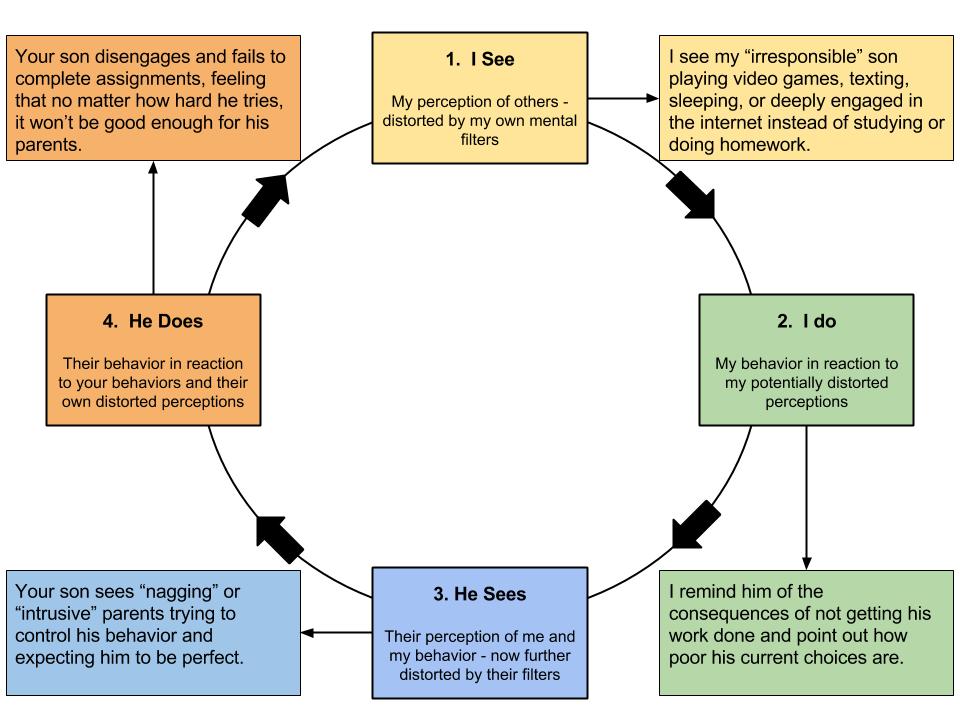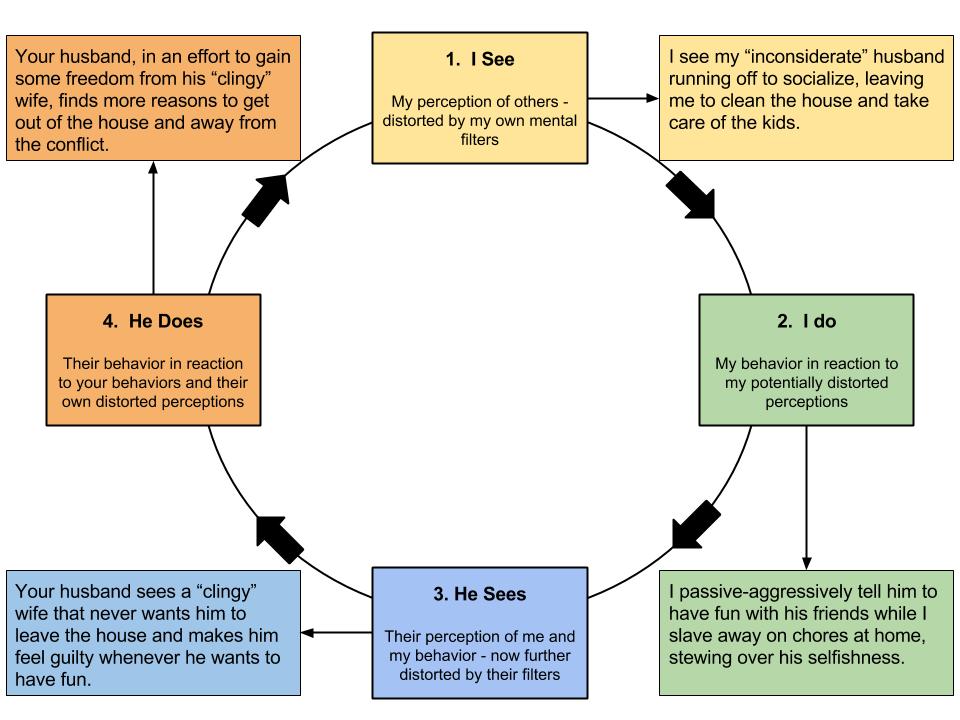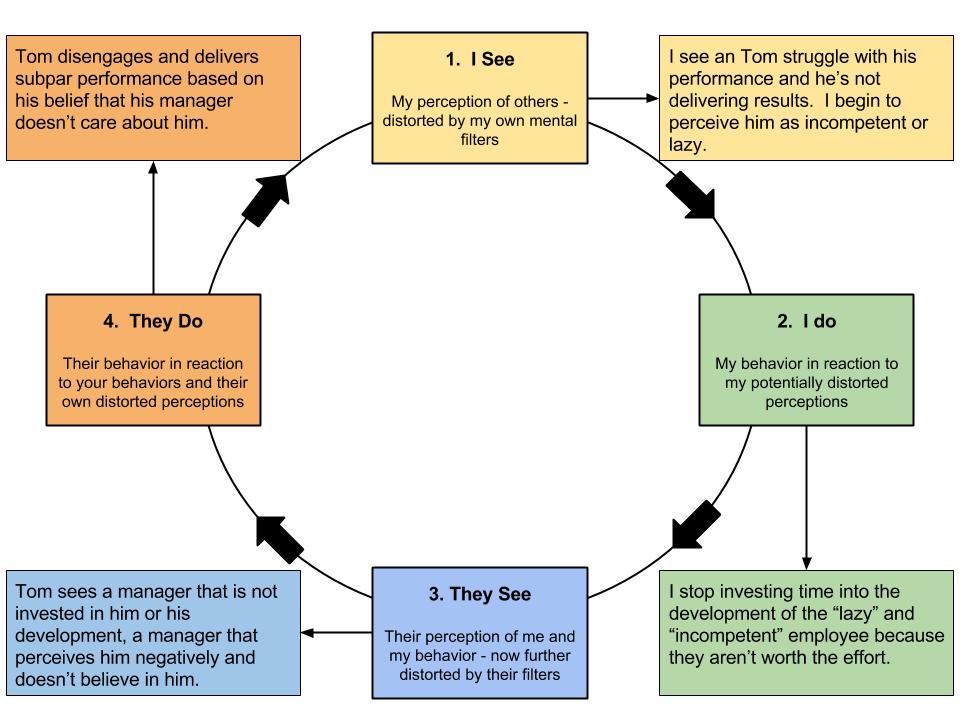Collusion implies that some form of secret collaboration has occurred in an effort to deceive others. This sounds like the stuff of political espionage and spy movies, so it may surprise you to learn that you’ve been colluding with others on a daily basis, unintentionally sabotaging relationships while justifying your own righteous perceptions and behaviors. An explanation is required. I’ve previously recommended The Anatomy of Peace, and the cycle of collusion comes directly from that text. On the most basic level, the cycle of collusion demonstrates how our own distorted perceptions and judgments about other people lead to interpersonal behaviors that act as a catalyst, promoting unwanted behaviors and confirming our negative perceptions.

The perceptions that feed our behaviors also provide fuel for the perceptions and behaviors of others. A feedback loop resulting in a self-fulfilling prophecy is created. If I believe you to be a certain way, I will treat you accordingly, and increase the likelihood of you responding in a confirmatory fashion. If this makes sense theoretically, the implications become even more powerful when looking at specific examples. Parents, partners, and coworkers all find themselves colluding as everyone exhausts themselves in an effort to justify their own behaviors as well as their perceptions of each other.
Here we see a common cycle for the parents of an adolescent.

Now let’s look at how partners set themselves up to fail.

And one more example – the workplace.

With each of these examples, we clearly see how the initial perceptions feed into the eventual behaviors that serve as evidence for the perceptions. Grrr….the frustration is mounting. How do we make it stop? Well, the kid could start doing his homework, the husband could stay in a bit more, and Tom could show a little more effort…but, that wouldn’t really solve anything. The real issue, and the place to focus energy, is the perceptions and behaviors associated with the “I see” and “I do” boxes.
It is too easy to holds other responsible for changing interpersonal dynamics, too easy to avoid personal accountability in these situations. So, you have to be intentional about focusing on the “I.” Shift perceptions of the adolescent from “irresponsible” to something more benign like “normal teenager,” “distracted,” or “in need of a break” and any interaction is likely to be more supportive. If the wife recognizes value in the husband’s desire to build and maintain his social life, it will be easier to encourage him to do so (genuinely), and paradoxically, he may be more motivated to stay home with his wife. That employee that isn’t delivering, may be waiting for his manager to show some compassion and investment before he’s willing to give his best.
Important note – these more positive perceptions do not let anyone off the hook in terms of legitimate feedback. That “normal teenager” may need some additional support in terms of academic tutoring, organizational skill development, or external motivation. We can increase the odds of that happening if we’re perceiving him in a positive light rather than as “irresponsible.” The husband and wife may need to sit down and have a conversation about shared responsibilities and time with friends, but it doesn’t need to include labels like “inconsiderate” or “clingy.” Tom may be under-performing, but assuming he is “lazy” or “incompetent” sets him up to be defensive and resistant in any conversations about his quality of work.
Exploring this process in it’s entirety can often shed light on long-standing conflict, hopefully elucidating changes necessary to break out of the cycle. To apply this theory to your day-to-day life, follow these simple action steps.
- Assume positive intent: Eliminate labels and replace negative perceptions with neutral or positive perceptions (
even ifespecially if it’s hard). - Help things go right: Criticizing, ruminating, and disengaging aren’t helping anyone move in a positive direction. Actively and intentionally look for ways to provide positive support. This may require a direct conversation or a trial-and-error approach.
- Take responsibility: When things don’t go how you planned, look at what you want to do differently next time. Identify whether your perceptions and behaviors were helping or hurting the dynamic.
- Stop expecting others to change: Accept your limitations. You have limited influence on how other people behave. Make sure you’re making it as easy as possible for them to move in a positive direction, communicate your expectations and your willingness to help, and then allow life to happen. You won’t always get the intended results, but you won’t be sabotaging yourself.



Great post, Doctor. Appreciate the insight.
“The Anatomy of Peace” was such a great read, thanks for your past recommendation. And thanks for this latest reminder of lessons that continue to apply.